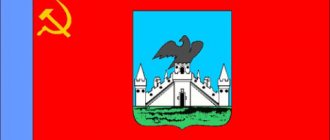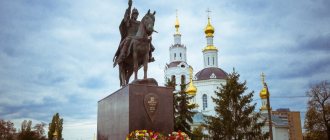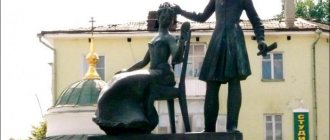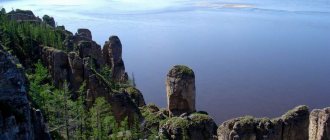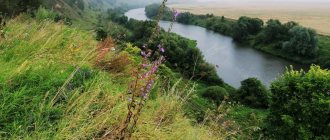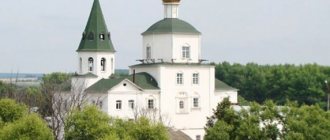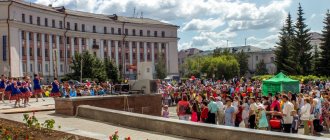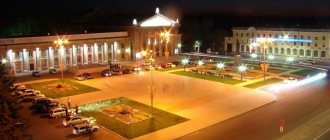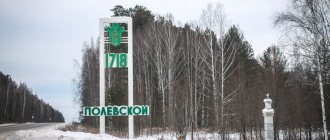| Route on your own Museums Stories, routes and tips from tourists Where to stay in Orel Interesting excursions Trips from the city for 1 day |
Orel is one of the ancient cities of Russia, founded in the middle of the 16th century as a fortress to protect the southern borders of the state from the invasion of the Crimean and Nogai Tatars. The city is more than four and a half centuries old; over the years it has witnessed many historical events. The city played a great strategic role in the Great Patriotic War; it is not for nothing that it bears the honorary title “City of Military Glory,” which is awarded to Russian cities “for the courage, fortitude and mass heroism shown by the city’s defenders in the struggle for the freedom and independence of the Fatherland.”
Orel is famous for being the birthplace of writers I. S. Turgenev and L. N. Andreev, philosopher M. M. Bakhtin, historian T. N. Granovsky. The life and work of N. S. Leskov, A. A. Fet, A. N. Apukhtin, who were born in the Oryol province, I. A. Bunin and many other outstanding people are connected with Oryol.
Oryol Fortress Photo: © Anna Kudryavtseva
What to see in Orel in 1 day on your own
The city has many historical and cultural attractions. It is clear that one day is not enough to get to know Orel in detail. It makes no sense to come specifically for just one day; only residents of nearby settlements can afford it. The city is quite far from Moscow, you can get there by high-speed train in 4 hours, you won’t be able to get there in one day.
But maybe you were passing through Orel or found a free day from a business trip. In this case, you need to decide in advance what you want to see in order to spend your time with the greatest benefit.
Let's see what you can see in Orel in one day on your own. We will go through a route for those who are in the city for the first time, which will allow you to see the main city attractions, form your impression of this glorious city and, perhaps, outline plans for continuing your acquaintance.
station Square
Sights begin immediately from Station Square. railway station itself is also interesting , consisting of two buildings completely different in architecture, connected by an underground tunnel. The station on this site was built in 1868, but it was destroyed in 1943 during the bombing of the city by our aircraft during the liberation of the city. The new station in the classicist style, designed by architect S. A. Mkhitaryan, was built in 1949–1950.
The most popular and photographed attraction on the square is, of course, the sculpture of an eagle - a symbol of the city. For a long time the sculpture was topiary, and in 2016, for the 450th anniversary of the city, it was replaced by a bronze eagle sitting on a symbolic globe.
Near the building of the Palace of Culture of Railway Workers, a “Monument to Railway Workers Who Made an Invaluable Contribution to the Victory in the Great Patriotic War” was erected. It will be interesting not only for adults, but also for children: it consists of a real steam locomotive, carriages and military equipment on platforms.
Sculpture “Eagle” on Station Square Photo: © Anna Kudryavtseva
Moskovskaya street
If you drive along the highway from Moscow, you enter Orel along the Moskovskoye Highway, which turns into Moskovskaya Street, leading to the city center. Once upon a time, the street was called Posolskaya, because Moscow ambassadors to the Crimean Khanate and Khan ambassadors to Moscow traveled along it.
Orel was included in the list of 15 largest and oldest Russian cities that suffered most during the Great Patriotic War. The occupation caused great damage to the city; much was destroyed during the battle for the liberation of Orel. But on Moskovskaya there are buildings of the 19th and 20th centuries that are included in the lists of cultural heritage of regional and even federal significance. For example, the House of the merchant Apollonov with mascarons and rich stucco decorations, which is now occupied by the Oryol Technical School of Transport. Or the House of Merchants Perelygins of the mid-19th century, which housed the Headquarters of the 17th Chernigov Hussar Regiment from 1896 to 1914. In 2016, a monument to the Honorary Citizen of the city, Grand Duke M.A. Romanov, the commander of this regiment formed in Orel, was erected near the house.
The monument to a native of the Oryol region, aircraft designer N. N. Polikarpov, who was called the “king of fighters,” deserves attention. It is installed on Moskovskaya Street in the park named after him.
Headquarters building of the 17th Chernigov Hussar Regiment Photo: © Anna Kudryavtseva
Hotel "Eagle"
From the station, in order not to waste energy, you can take public transport to the Orel Hotel, the transport stop is called that way. It is one of the city's most famous buildings, built between 1952 and 1955.
On the opposite side of Moskovskaya Street, it is worth paying attention to the building of the “House of Books”, decorated along the facade with busts of Russian writers and scientists. It was also built in the middle of the last century, when the city was being restored after the war. The bookstore still exists there, but the main premises are occupied by banks.
Hotel "Eagle" Photo: © Anna Kudryavtseva
Tankmen Square
Tanker Square is the most famous landmark of Orel; before the Great Patriotic War it was called Pervomaisky. On October 3, 1941, Orel was captured by the 4th Panzer Division of the 2nd Panzer Group of General Guderian, part of the German Army Group Center.
The city was occupied for almost two years; it was liberated on August 5, 1943 during the Oryol offensive operation “Kutuzov”. In honor of the liberation of Orel and Belgorod, the first artillery salute in the history of the Great Patriotic War was given in Moscow. Now Oryol is called “the city of the first fireworks.” Victory Day and Oryol Liberation Day are the main holidays of the city.
The tankers who died in the battles for Oryol were buried in Pervomaisky Square in a mass grave on August 6, 1943. Since then it has been called Tankers Square, a T-34 tank is installed on the pedestal, and the Eternal Flame burns in memory of those who fell for the liberation of Orel. In 2016, a monument to Marshal I. Kh. Bagramyan, who commanded the troops that liberated the city, was erected in the park.
Monument to the liberators of Orel Photo: © Anna Kudryavtseva
Red Bridge
There are two rivers in Orel - the Oka, which originates in the Oryol region, and the Orlik, so there are several bridges in the city. Our path lies across the Red Bridge, which connects Moskovskaya and Gostinaya streets on different banks of the Oka.
On the site of the modern Red Bridge there was the Mariinsky Bridge, built in 1877–1879 by engineer A. Lebedinsky and named in honor of Empress Maria Alexandrovna, wife of Alexander II. In 1919 it was renamed Krasny. In 1943, during the retreat, the Nazis blew up all the bridges in the city. The new bridge was built in 1950 on the surviving supports of the Mariinsky Bridge.
Red Bridge over the Oka Photo: © Anna Kudryavtseva
Epiphany Cathedral
The Red Bridge offers the best view of the Epiphany Cathedral , the oldest building in the city and the only thing left of the Oryol Fortress. The Epiphany Church was built in the first decade of the 18th century in a style referred to as the “Naryshkin Baroque”. In 1837, the church was completely rebuilt, after which it acquired a classical appearance; only the bell tower and the dome of the church were reminiscent of Baroque. The rickety bell tower was replaced in 1908–1912.
The temple was closed in 1937, the church fence and the new bell tower were dismantled into bricks. During the years of occupation, the clergy turned to the German authorities of the city with a request to open churches; the Epiphany Cathedral was the first to open in October 1941. It did not close even after the end of the war, and in 1947 it became a cathedral. But a new anti-religious campaign began, and in 1962 the Epiphany Cathedral was closed again: the crosses were removed, the domes were dismantled, the frescoes were plastered over, and the building was adapted for a puppet theater.
The building was returned to believers in 1995, then the restoration of the temple took place over two decades. The Epiphany Cathedral acquired its curtained appearance only in 2015, when a dome and a cross were erected on the bell tower.
Monument to Ivan the Terrible against the background of the Epiphany Cathedral Photo: © Anna Kudryavtseva
In 2016, a monument to Tsar Ivan IV the Terrible , the founder of the city, was erected in the park next to the cathedral - in 1566, by his decree, the Orel fortress was founded. The king is depicted sitting on a horse, in his right hand there is a cross, and with a sword in his left hand he indicates the location of the future fortress. That's where we'll go.
Memorial Park of the 400th Anniversary of the Eagle
The main natural attraction within the city is the spit of the Oka and Orlik, the confluence of the Oka and its left tributary Orlik. It was here that the Oryol fortress was founded in 1566. In 1966, a Memorial Square was laid out on this site, a stele was erected in honor of the 400th anniversary of the founding of the city, and next to it was the Monument to the Liberators of Orel on August 5, 1943.
Stele in honor of the 400th anniversary of the founding of the city of Orel Photo: © Anna Kudryavtseva
Children's park
From Memorial Park you can cross the bridge to the Children's Park, which was recently opened after a large-scale reconstruction. If you are with a child, you will not be able to leave this park quickly; there is something interesting for children of all ages: rides, numerous swings, a new “flat” fountain and a restored “Horses” fountain. Adults can simply relax on a bench or admire the views of the river. You need to leave the park via the suspension bridge near the Epiphany Cathedral; by the way, this bridge is also a city landmark.
Children's park Photo: © Anna Kudryavtseva
Gostiny Dvor
We go out onto Gostinaya Street, which starts from the Red Bridge. The main building here is Gostiny Dvor . Gostiny Dvor, combined with shopping arcades, was built on this site in the early 1780s, but it burned down along with its goods in a big fire in 1847. In 1849, with the money of local merchants, they began to build a new two-story stone guest courtyard designed by architect D. V. Orekhov.
It took a long time to build, five whole years, but the result was worth it: the building became a decoration of the city and the center of city trade. The first floor was occupied by the best shops of famous Oryol merchants, and it is still used for shops. Gostiny Dvor was badly damaged during the war; during its restoration, a third floor was added and a passage arch was made at the site of the destruction. The upper floors are now occupied by various organizations. For example, since 1932, the left wing has housed the Oryol Museum of Local Lore. The architecturally similar building on the opposite side of the street was built for symmetry during the post-war reconstruction of the city.
Photo: © Anna Kudryavtseva
Theater "Free Space"
The building of the Free Space Theater, as the Oryol Theater for Young Spectators has been called since 1990, is one of the oldest civil buildings in the city. It was built in 1799 for the Magistrate, then the City Duma; the center of local government was here until the revolution. During the war, the building received significant damage; during the restoration of the city, it was rebuilt, but the semi-rotunda of the main entrance with a dome was preserved. The Theater for Young Spectators has been located here since 1981.
Theater "Free Space" Photo: © Anna Kudryavtseva
Bank building
It is impossible to pass by the bright building next door; it is too different from the general architectural ensemble of the city: red facing bricks, stone carvings and glazed tiles on the facades. The façade of the building facing the embankment of the Orlik River is no less beautiful. This building in the pseudo-Russian style was built in 1897–1900 according to the design of the Moscow architect S.K. Rodionov for the Oryol Commercial Bank founded in 1892.
After the revolution, it was occupied by the gubkom of the RCP (b) - the All-Union Communist Party of Bolsheviks (Bolsheviks), then by the gubkom of the Komsomol, and during the years of the German occupation - by the Gestapo. But for many years now the building has been used again for its intended purpose, as it was one hundred and twenty years ago. Now the Oryol branch of the Central Bank of Russia is located here.
Oryol Region Branch of the Main Directorate of the Central Bank of the Russian Federation for the Central Federal District Photo: © Anna Kudryavtseva
Monument to A.P. Ermolov
The monument to A.P. Ermolov, a Russian military leader and statesman, a participant in many major wars that the Russian Empire waged from the 1790s to the 1820s, was erected on the square named after him in 2012. The author is Moscow sculptor Ravil Yusupov, who recreated the general’s face based on his famous portrait by artist George Dow. And the monument was built with money collected by Oryol residents.
A.P. Ermolov has a direct connection to Orel: he came from poor nobles of the Oryol province, where his father had a small estate. Here he lived for some time after his resignation in 1827 and bequeathed to be buried in Orel next to his father. A.P. Ermolov is buried here at the Trinity Cemetery.
Monument to General A.P. Ermolov Photo: © Anna Kudryavtseva
Gymnasium building
On the square stands the building of the history department of the Oryol State University. I. S. Turgeneva. This is the building of the former Oryol men's gymnasium , an architectural monument of federal significance. The building was built in 1795 for a public school, it is the oldest civil building in the city. In 1808, a 4-year men's gymnasium was opened on the basis of the school, and in 1828 it became a general educational institution with a 7-year course of study.
There are busts of the most famous graduates of the gymnasium near the building. Writers N. S. Leskov and L. N. Andreev, polar explorer V. A. Rusanov, artist G. G. Myasoedov, astronomer P. K. Sternberg and others studied here. P. A. Stolypin, the future Minister of Internal Affairs and Chairman of the Council of Ministers of the Russian Empire, was also a graduate of this gymnasium.
Faculty of History of Oryol State University named after. I.S. Turgeneva Photo: © Anna Kudryavtseva
Monument to N. S. Leskov
The city has monuments to, perhaps, all the writers who were born in the Oryol region, or whose work was connected with these places. But the most interesting is the monument to Nikolai Sergeevich Leskov, which since 1981 has stood in the park named after the writer, next to the Assumption Cathedral.
N. S. Leskov is depicted sitting on a sofa, around the columns there are sculptures of characters from his famous works “Lefty”, “The Stupid Artist”, “Lady Macbeth of Mtsensk”, “The Cathedral People”, “The Enchanted Wanderer”.
The Assumption Cathedral (Cathedral of the Archangel Michael) also deserves attention - a striking work of the classicist era, built in the first quarter of the 19th century.
Monument to N.S. Leskov surrounded by characters from his works Photo: © Anna Kudryavtseva
Alexander Bridge
The bridge over the Orlik River was opened in 1880 and named Aleksandrovsky in honor of the 25th anniversary of the reign of Alexander II. After the revolution, the bridge was renamed Leninsky. In August 1943, the bridge was blown up by German troops during their retreat; after the liberation of Orel, it was restored to its original location. Since the late 1970s, the bridge has become a pedestrian bridge; before that, trams ran along it. At the beginning of this century, the bridge underwent a major reconstruction; it was practically rebuilt.
The views that open from the Alexander Bridge to the Orlik River, the walking areas along its banks, and the Epiphany and Assumption Cathedrals are noteworthy.
Alexander Bridge over Orlik Photo: © Anna Kudryavtseva
Lenin Street
Along the Alexander Bridge you get to Lenin Street, the main pedestrian street of Orel, beloved by locals and tourists. That’s what it was called in 1919; before that the street was called Bolkhovskaya. By the beginning of the 20th century, it was the most beautiful street in the city; the city’s nobility lived here and the most fashionable shops, hotels, pharmacies, and photographs were located here. Electricity was installed on Bolkhovskaya in 1895 and it became a favorite place for the public to take evening walks. In 1893, tram lines were laid here, and trams ran along Bolkhovskaya for eight decades. By the way, the Oryol trams are also a landmark; they are one of the oldest tram systems in Russia, only Nizhny Novgorod’s is older.
Many buildings on Lenin Street are architectural monuments, the most famous being the corner building opposite the Pobeda cinema. In this house there was a hotel of the merchant E.K. Jordan, in different years the writers I.S. Turgenev and P.I. Yakushkin stayed there, and there was also a library, to which the young I.A. Bunin was a regular visitor. The Pobeda cinema was built in the 1950s on the site of the St. George Church destroyed during the war.
Local artists sell their works on Lenin Street Photo: © Anna Kudryavtseva
Lenin Square
Lenin Street ends at Lenin Square - the main square of the city, where all major city events and parades take place, and on New Year's Day, a skating rink is poured and a large Christmas tree is installed. There are many important city buildings on the square: the Administration of the Oryol Region, the Oryol State Academic Theater named after. I. S. Turgenev, Main Post Office, two large hotels.
Pay attention to the Art Nouveau building, built in 1908 for the Northern Bank; in Soviet times it was occupied by ATS, and now by Promsvyazbank. The third floor and roof, uncharacteristic of modernism, were added already in the 2000s.
Hotel "Salut" and the building of the Northern Bank Photo: © Anna Kudryavtseva
Victory Boulevard
Look behind the Oryol Region Administration building (House of Soviets) on Victory Boulevard. It appeared on the city map in 1982, on the eve of the celebration of the 40th anniversary of the liberation of Orel. At the same time, a monument to Hero of the Soviet Union, Army General A.V. Gorbatov, commander of the 3rd Army of the Bryansk Front, which liberated the city in August 1943, was erected in the center of the boulevard.
In April 2007, Orel was awarded the honorary title “City of Military Glory,” so in 2010 a stele was installed on Victory Boulevard.
Stele “City of Military Glory” on Victory Boulevard Photo: © Anna Kudryavtseva
Park of Culture and Recreation
The Oryol Culture and Recreation Park will soon be two hundred years old. It was founded on the high bank of the Oka in 1822, thousands of trees and shrubs were planted, bridges were built across ravines, and surrounded by a wooden fence. The garden was inaugurated in May 1823, and from the first day it was public. On holidays, gypsy choirs performed here and fairs were held. The Oryol public garden was considered the best among such gardens in other provincial cities.
L. N. Tolstoy and I. S. Turgenev, L. N. Andreev and M. Vovchok walked along the alleys of this garden in different years. Why don't you take a walk like this? For example, look at the “Turgenevsky Berezhok” to the monument to I. S. Turgenev, from there there are excellent views of the Oka River and the Dubrovinsky embankment.
Monument to I.S. Turgenev Photo: © Anna Kudryavtseva
Holy Dormition Monastery
Further along the way you can go to the Holy Dormition Monastery , founded on this site in 1680. The monastery, like the others, was closed by the Bolsheviks; of its six churches, only the small Holy Trinity Church has survived - the ancestral tomb of the family of the Oryol governor A.V. Kochubey. Now this church is the temple of an Orthodox gymnasium.
The revival of the monastery began in 1991: the Cathedral of the Kazan Icon of the Mother of God, the Church of the Assumption of the Blessed Virgin Mary, the Alexander Nevsky Chapel were built, the most beautiful Cathedral of the Annunciation of the Blessed Virgin Mary is under construction.
Holy Dormition Monastery Photo: © Anna Kudryavtseva
From the stop on 60 Let Oktyabrya Street near the monastery you can go to the station, thus completing a one-day route around Orel.
Attractions in the surrounding area
Saburovskaya fortress
Coordinates: N 52° 54.554′ E 35° 54.048′ How to get there: from Orel by bus No. 7 to the Possovet stop
The structure was built on the initiative of Count Mikhail Fedotovich Kamensky (1738-1809), a participant in two Russian-Turkish wars. The territory of the fortress occupies about 18 hectares and is located on the site of the former Saburovo estate, received as a gift from Empress Elizabeth Petrovna by Kamensky’s father.
The fortress walls, 4 meters high, reminiscent of the fortifications of the Istanbul Fortress, the baroque building of the Church of the Archangel Michael and four observation towers have survived to this day.
Now the fortress is being actively restored.
Museum-Reserve "Spasskoye-Lutovinovo"
Address: Mtsensky district, village. Spasskoye-Lutovinovo Phone: 8 (4864) 66‑72-14, 8 (4864) 66‑73-00 Website: https://spasskoye-lutovinovo.ru Opening hours: Mon-Sun 9:00-17:00
The cultural and historical complex is located on the family estate of the writer Ivan Turgenev, where his most famous novels were written.
Here is the writer's house-museum, consisting of several living rooms, a library with billiards, a bedroom, a study and a number of small utility rooms.
Adjacent to the house is a park with Turgenev’s favorite place for reflection - an old hunting lodge.
The place is also known for the fact that many thinkers of that era, for example, Lev Nikolaevich Tolstoy, came here to visit the writer.
Oryol Polesie
Address: Khotynetsky district, Zhudre village Telephone: , Website: https://orlpolesie.ru Cost: 1000 rubles for a group of 10 people
The reserve park was organized in 1994 to ensure the protection of the ecosystems of southern Russian coniferous forests and their inhabitants.
The park, with a total length of about 78 hectares, is home to about 285 species of animals, half of which are rare and endangered species: European bison, Russian muskrat, gray shrike and others.
Literary and local history museum "Turgenev Polesie"
Address: Khotynetsky district, village. Ilyinskoye Phone: , Opening hours: Tue-Sun 08.00-17.00, Mon - closed Cost: free
The museum has been operating since 1991, and it stores all historical documents related to Oryol Polesie.
Several exhibitions are presented here, dedicated both to the creative heritage of Ivan Sergeevich Turgenev and his contribution to the development of the region, and to the life of Oryol peasants.
The museum contains household items, festive and everyday clothing of peasants from past centuries and today. Here you can also look at the collection of butterflies and rare plants.
In the museum you can listen to ancient folklore compositions performed by the folk ensemble “Kalinovy Sadok”, whose musicians perform in authentic dresses of their great-grandmothers, local residents.
If you have not yet chosen where you will live and want to save money when booking, we recommend using the RoomGuru service. Firstly, it contains hotels, apartments and guest houses from many different booking systems, so you won’t miss out on a worthwhile option. Secondly, you can immediately compare prices for one place in different services and book where it is cheaper (this is not always Booking!).
Orel Museums in 1 day
There are many museums in Orel, the oldest of them is the Museum of Local Lore , founded in 1897, and the youngest is the Museum of Collectible Dolls, opened in 2016. You can choose to visit the one that interests you.
Oryol United State Literary Museum of I. S. Turgenev
“The Oryol United State Literary Museum of I. S. Turgenev” includes six literary and memorial museums, the exhibitions of which are located in noble mansions of the 19th century:
- Museum of I. S. Turgenev
- Museum of Oryol Writers
- Leskov House-Museum
- House of Leonid Andreev
- Museum of I. A. Bunin
- House of T. N. Granovsky
Museum I.A. Bunina Photo: © Anna Kudryavtseva
Oryol Military History Museum
The exhibition of the Oryol Military History Museum is dedicated to the pages of the military history of the Oryol region and the participation of Oryol residents in the largest military campaigns of the 18th - early 20th centuries. Much attention is paid to the topic of liberation of the region from the Nazi invaders during the Great Patriotic War.
In the museum you can visit eight halls, where among the exhibits are rare collections of weapons and ammunition of warriors from different historical periods. The dioramas that attract the greatest interest among visitors are: “Breakthrough of the Nazi defense in the Oryol direction near the village of Maloye Izmailovo, Novosilsky district, July 12, 1943.” and “The Battle of Kromy in the fall of 1919 during the Civil War.”
Oryol Military History Museum Photo: © Anna Kudryavtseva
Memorial House-Museum of V. A. Rusanov
This unique museum of its kind was opened in Orel on Rusanova Street in 1982 in the house where V. A. Rusanov spent his childhood and youth. There are few museums dedicated to explorers of the North and the Arctic in Russia; the peculiarity of the House-Museum of V. A. Rusanov is that in the center of Russia, in the literary region, a museum of a polar explorer has been opened.
Rusanov gave his life in his attempt to explore and navigate the Northern Sea Route, a very economically beneficial route for Russia. The tragic death of the researcher still remains a mystery, and the museum’s exhibition tells about the attempts of our contemporaries to uncover this mystery. It was V. A. Rusanov who was the prototype of the hero of Veniamin Kaverin’s story “Two Captains”.
Memorial House-Museum of V. A. Rusanov Photo: © Anna Kudryavtseva
More information in the material Eagle Museums
Brief history of the city of Orel
Orel was founded at the confluence of the Oka and Orel (later Orlik) rivers in 1566, during the reign of Ivan the Terrible
, like a border military fortress. Under Peter I, it ceased to be a fortress and, thanks to its advantageous position in the upper reaches of the Oka, became a major river port and center for trade in grain and salt.
In 1778 it became the center of the Oryol province
. In 1868, a railway appeared in Orel, and all trade moved to it, and the port-marina on the Oka fell into decay.
During Soviet times, Orel retained its administrative significance - as the center of the Oryol region
.
During the Second World War it was occupied by the Nazis for almost two years. Liberated on August 5
, 1943. In honor of the liberation of two cities - Orel and Belgorod - the first victory salute during the Second World War was given in Moscow - since then Orel has been called
the City of the First Fireworks
.
In the post-war period, Oryol significantly expanded its territory. A new district of the city has appeared, today called the Northern.
Eagle coat of arms.
Map of Orel from the early 20th century.
Districts of Orel.
Stories, routes and tourist tips
If you are going to Oryol, we recommend that you read the real reviews of tourists who visited the city. Perhaps their experience will be useful to you.
Take a look at the tourist materials:
- Impressions of Andrey and Valeria’s trip “Eagle in the year of the 200th anniversary of I. S. Turgenev”
- Photo album of Lyudmila “City under the wing of an eagle”
- Anna's stories "Eagle - the city of military glory", "Literary Eagle"
We also remind you that the site has a “Questions and Answers” , where, if necessary, you can not only check with experts for up-to-date information about specific city attractions, but also seek advice on issues that interest you regarding your planned trip to Oryol.
All tourist reviews about the trip to Orel on Tourister. RU
Where to stay in Oryol
For a traveler seeking to better understand the historical places of Orel, the city offers accommodation in hotels, apartments, and hostels. If we take into account the central part of the city, lying on both sides of the Oka and full of attractions, hotels are rare and most do not have a specific category. There are a few more on the outskirts. Among them, the Grinn Hotel and Spa, located at the southern entrance along the Kromskoye Highway, stands out brightly - a large hotel in the shopping center of the same name and a park version in the ancient Russian style, Znamenskaya Bogatyrskaya Outpost. Apartments allow you to significantly expand your search options closer to the center, choosing, for example, apartments overlooking the Oka embankment.
- Oryol Hotels
- Hostels for Budget Travelers
- Flats and apartments
Bonus when booking accommodation with Booking.com and Tourist. Ru - cashback for your profitable trip. Cashback promotion for Tourist. RU
Museum of Fine Arts Photo: © Anna Kudryavtseva
Districts of Orel
Historically, three districts have developed in Orel around the founding site of the city - the Oka and Orlik arrows, the borders of the districts being the rivers themselves:
- Factory
district (old names: 1st part, Old Town) - it was in this part that there was the Oryol fortress, there was the oldest urban settlement - Posadskaya, before the revolution, mainly merchants and townspeople settled here; in Soviet times, large machine-building plants were built - hence the name; - Zheleznodorozhny
district (2nd part, Zaokskaya part) - initially the district was formed around the Moscow road and Okskaya pier, then it grew thanks to the railway station; - Sovetsky
district (3rd part, Zaorlitskaya part, Upper Town) - the administrative part of the city since the abolition of the military fortress; Before the revolution, mainly nobles settled here, after - the Soviet nomenklatura; this area has more museums than others.
In 1999, the fourth district of Orel, Severny
.
Interesting excursions
In Orel, as in any other large city in the country, you have a great opportunity to get to know the city better by using the services of travel companies or private guides.
If this is your first time in Oryol, you can start with an overview of the city. A walking tour is possible, and if you come with your own transport, then a tour in your car. You will learn all the most interesting things about the history of the city from the first inhabitants to the present day, see and photograph all the iconic city attractions and get answers to any questions you may have. In the summer, it is possible to take a boat tour along the Oka River, during which you will get acquainted with the natural and geographical position of Orel, its administrative structure, and attractions along the boat route. There are many excursion options: “Merchant Eagle”, “Eagle - a journey through time”, “Along the Kursk streets of Orel”, “Eagle - past and present”.
You can go on a thematic excursion “Literary Eagle”, during which you will be taken along the routes of writers whose destinies are closely connected with Orel, and will be introduced to the rich literary traditions of the city, which is called the literary capital of Russia. As part of the excursion, you can visit your choice of one of the literary museums of Orel. Excursions on a narrower topic are also possible, for example, “The Eagle in the Works of Leskov”, “Turgenev’s Places in Orel”.
Gazebo in the park “Noble Nest” Photo: © Anna Kudryavtseva
There are excursions outside the city. For example, the excursion “Krivtsovsky Memorial”, dedicated to the memory of the difficult days of the Great Patriotic War - the battles in the Bolkhov direction in February-March 1942. Or the excursion “To the Frontiers of Glory in Novosil”, where you will learn about the role and significance of the Oryol offensive operation, the heroism of the soldiers and commanders at the initial frontiers in the summer of 1943. There are dozens of options available, you can always choose what suits your interests.
Excursions “Across the Native Land of I. S. Turgenev” are always popular, during which they talk about the life and work of the writer, and also visit the Turgenev family estate Spasskoye-Lutovinovo .
Reviews from tourists about visiting the Spasskoye-Lutovinovo Museum-Reserve
Spasskoye-Lutovinovo Museum-Reserve Photo: © Andrey Semenov
Beautiful places in Orel that are worth visiting
The Oryol region is rich in historical sights and untouched natural beauty. True Russian nature and famous places full of folk cultural traditions arouse the genuine interest of travelers from all over the world.
Oryol Polesie National Park
The protected areas of the national park occupy a vast territory. Here, Polesie, which has preserved its uniqueness, combines amazing nature and the historical heritage of the people.
There is no need for a tourist to visit Belarus to see a live bison. The giant bull also lives here, in the Oryol region. Experienced guides will help you walk along a comfortable ecological path to see this interesting miracle of nature. The park's areas include forested areas equipped with recreation areas, an open-air zoo of rare animals and birds, archaeological monuments, the Radovishchi settlement, and an old village. It's interesting to walk there.
Location: village. Zhudersky.
Opening hours: every day, 10.00-17.00.
You can get there by bus “Orel - Khotynets”, then by minibus to the stop “Usadba Polesya”.
Get directions
Source of Saint Kuksha
In the old days there lived Saint Kuksha, who preached Orthodoxy in the Oryol lands. The idol worshipers killed the saint. At the place of Kuksha’s death, a miraculous spring began to flow. Later a monastery was built and the spring was improved. Finding the source is easy. Wooden paths lead to the spring, a font is equipped, and a small church is built.
Location: village. Mtsensk.
You can visit the source 24 hours a day.
Travel by bus 128 to the Frolovka stop.
Get directions
Kuznetsovskie ponds
The townspeople's favorite vacation spot spreads over 25 hectares. Shallow ponds are rich in carp, grass carp, crucian carp, perch, and pike. They are separated by sectors for fishing and recreation. Picturesque places and sandy beaches have long been loved by local residents. Despite the active visitation by vacationers, free recreation areas - gazebos, tables, barbecues and bridges - are kept clean.
Location: Bolkhovsky district.
You can get there by bus "Orel - Kuznetsovsky".
Get directions
Cave "Water"
Thrill-seekers will find something to visit in Orel. The old cave is located within the city. The height of the ceilings of the former quarry is from 1 to 3 meters. The depth of underground lakes is up to 3 meters. The water is absolutely clear. Some places consist of clay islands. Others are completely flooded. Therefore, it is important that tourists are accompanied by an experienced speleologist. They travel around the cave only by boat.
Location: right bank of the Oka River, 500 m from the pier.
Excursions are possible during daylight hours.
Travel by tram 4, stop “Moldavskaya”, then walk to the pier or by car.
Get directions
